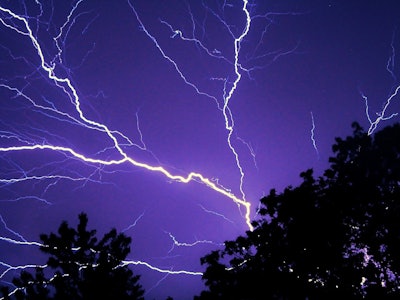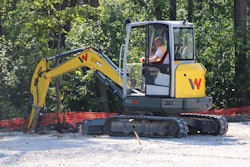 Photo: Pixabay
Photo: PixabayDuring the heat of summer, sudden thunderstorms are not uncommon, but they should not be ignored as they can pose a serious occupational hazard to crew members. Lightning kills an average of 49 people each year in the United States and hundreds more are injured, according to the National Weather Service.
The odds of being struck by lightning any given year is 1.1 million, but those who are working outside in open spaces are far more at risk. There are three main factors for lightning deaths when outside. The victims are typically out in the open, a good distance from shelter, and fail to take action early.
There are five different ways that lightning can strike people. A direct strike is when a person becomes part of the main lightning discharge channel. This most often occurs in an open area. These are not the most common type of strike, but they can be the deadliest.
A side flash is when the lightning strikes a taller object that the individual is near, and part of the current strikes the victim as well. This happens most often when a person has taken shelter under a tree.
Anyone outside near a lightning strike can be affected by a ground current. This is when the energy from a strike travels in and along the ground surface. The majority of lightning deaths and injuries come from ground currents.
Conduction occurs when lightning travels along a metal surface. Streamers are the least common type of lightning injury. Streamers develop as the leader moves down toward the ground.
As an employer, it is important to communicate the threat that lightning poses and have a safety plan in place.
Prior to starting any work, supervisors should monitor National Oceanic and Atmospheric Administration (NOAA) weather reports. While working outdoors, keep an eye on darkening clouds and increasing wind speeds that can indicate developing storms.
Monitor local weather reports regarding thunderstorm activity and severe weather while working. After hearing thunder or seeing lightning, supervisors, and employees should stop work and know what buildings to shelter in.
A safe shelter is an established building with electricity or plumbing. The secondary choice of shelter is a fully enclosed metal vehicle with the windows up. Wait at least 30 minutes after the last clap of thunder to resume work.
There is no safe place outside during a thunderstorm, but these actions can help reduce the risk of being struck if you or a crew member is caught outside:
- Avoid elevated areas and isolated tall objects such as trees.
- Never lie flat on the ground.
- Immediately move away from ponds, lakes, and other bodies of water.
- Stay away from objects that conduct electricity.
If a co-worker happens to be struck by lightning, immediately help the person. Victims do not carry a charge. Cardiac arrest can occur if someone is struck, so check for breathing and a pulse. Perform CPR if trained; otherwise, call 911.
Treat electrical burns with a dry, sterile bandage, but do not try to cool the burn. If possible, move the victim to a safer place, away from the risk of another strike.
Aside from immediate issues a landscape worker might experience from being struck by lightning, there are also long-term symptoms to be aware of.
Headaches, dizziness, ringing in the ears, slower reaction time, trouble with multitasking, difficulties with sleeping, inattentiveness or forgetfulness, irritability, and personality change, chronic pain from nerve injury, and issues with coding new information/accessing old information are all possible side effects of being struck by lightning.
There is no specific treatment for surviving a lightning strike but the National Weather Service advises finding a support network and doctor that is willing to listen and work with the victim.
There are plenty of myths surrounding lightning strikes. Here are a handful of them and the truth about these misconceptions.
Myth: If it’s not raining or there aren’t clouds overhead, you’re safe from lightning.
Fact: Lightning is unpredictable and can strike outside of rainfall areas. It can even strike 10-15 miles from the thunderstorm.
Myth: If trapped outside and lightning is about to strike, lie flat on the ground.
Fact: Lying flat increases your chance of being affected by ground current. If you are caught outside in a thunderstorm, keep moving towards shelter.
Myth: Structures with metal or metal on the body attracts lightning.
Fact: Height, shape, and isolation are the dominant factors controlling where lightning will strike. While metal does not attract lightning, it does conduct it. Avoid metal structures such as bleachers or fences.










